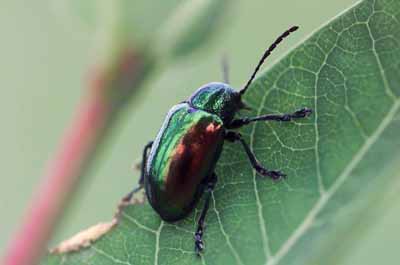
Dogbane Leaf Beetle
(Chrysochus auratus Fabricius)
Interesting facts:
The dogbane leaf beetle has a special type of color that shines and changes as the insect changes position or we change position looking at it. This changing color is called iridescence. The beetles' iridescence is produced by special body structures and light. The surface of the body parts of this beetle is made up of stacks of tiny, slanting plates, under which is a pigment (substance that produces color). Some light rays reflect from the surface of the plates, and other light rays reflect from the pigment underneath. At different angles, the light reflects at different speeds, causing interference and resulting in our seeing different colors that shine. See Web Resources section for more information on insect iridesence.
Description:
The dogbane leaf beetle is a small (8-11 mm.), oblong, shiny insect that displays blue, gold, green, and coppery colors. Its underside is bluish-green. It has wide-set atennae with eleven segments. The larva is white with a brown head. It feeds on roots and leaves of dogbane and other milkweed plants.
Habitat and behavior:
The female lays eggs on the ground or on the milkweed plant. The larvae tunnel through the soil to feed on the roots. Then they pupate in the soil.
Food:
Dogbane leaf beetles feed on prairie plants such as milkweeds (Asclepias sp.), Indian hemp, and dogbane (Apocynum sp.).
Predators:
Dogbane leaf beetles avoid some predators by giving off a foul-smelling secretion when they are touched.
Distribution and status:
The dogbane leaf beetle is found from the Atlantic coast to Texas, and north to Saskatchewan, Canada.
Location in Illinois:
The dogbane leaf beetle is very common on Illinois prairies and other grasslands. It is found throughout Illinois on roadsides, railroad right-of-ways, and abandoned fields where milkweed grows.